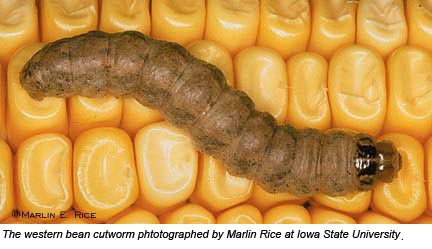Western Bean Cutworm Also Likes Corn
Western Bean Cutworm Also Likes Corn

Names can sometimes be misleading, and that’s just the case with the western bean cutworm, an emerging pest that could make its way into western Kentucky this year. Rather than beans, its target in this state will likely be corn, and it does its damage by feeding.
“In some ways it acts more like the corn earworm in that it attacks the developing ear and kernels,” said Ric Bessin, entomologist with the University of Kentucky Cooperative Extension Service. “Since this is the part of the plant we market, we consider this a direct pest – one that attacks the part of the plant we sell.”
The cutworm was first identified as a pest in dry beans and then was discovered to also feed on corn. It has been gradually migrating east and by 2005 had made its way across Iowa and into parts of Illinois. Last year, it had spread across Illinois, and the first moths could reach Kentucky by this summer. Trapping for this new pest will begin this summer in western Kentucky, Bessin said. The pest is not expected to become a problem in the state for a few more years, and there are control measures available when needed.
The cutworm overwinters as a larva in the soil and pupates in the spring. The moths begin to emerge in June and July, and larvae emerge from eggs laid on the upper sides of leaves. They will feed on the upper leaves and tassel before moving to the silks and ear. In the ear, they feed on the developing kernel.
“When feeding is complete they drop to the soil,” he said. “Fortunately, there is only one generation per year. But unlike the corn earworm, where only one larva completes development per ear because the larvae are cannibalistic, this is not the case with the bean cutworm. There can be one or more per ear, and there are examples of 10 or more in a single ear. Also, unlike corn earworm that attacks only the tip of the ear, the bean cutworm can attack the tip, side or butt end of the ear.”
Western bean cutworm moths are dark brown with a white stripe on their upper wings and are about three-fourths of an inch long. Larvae are about one-quarter of an inch long when hatched and can grow to a length of 1.5 inches. Young larvae are tan and become a pale brown
as they develop. Older larvae have three light stripes on the back of their heads. The eggs are white when first laid and gradually change to tan and then purple as they develop.
Bt corn can be used as one option for controlling the pest, Bessin said. There are insecticidal treatments available as well. There is not expected to be any problems associated with this pest in 2007 in Kentucky. It will take one or more years before it builds up in numbers to affect profits in the field.
Information about western bean cutworm and other corn pests can be found through the county offices of the UK Cooperative Extension Service.
